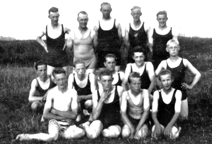Trinity Christian College in Palos Heights, Illinois, was founded in 1965 or thereabouts. It is a reformed Christian college, founded on the idea that science is not neutral, that all knowledge is influenced and shaped by a person’s worldview, and that Christians, therefore, need to study in a Christian College to reach an understanding of the world that is in harmony with their faith
You can buy it or not buy it. As a student, it was clear to me that the history and philosophy departments were trying their best to follow the program, but English classes seemed to me to be pretty well the same kind of classes you would be taking at York or the University of Toronto or the University of Western Ontario or the University of Chicago.
If you took art and needed to learn how to draw the human figure, you had to go to Saint Xavier University down the street to see a nude model because, apparently, Christians didn’t do nudes. Well, at least not on Trinity’s campus. I’m amazed we had a pre-med program– when did they ever get to look at a human body?
As for the business and accounting departments, they were all eager little capitalists who believed that religion was largely relevant to Sunday mornings. The philosophical perspective of my friends in these departments could be summed up thusly: “Hey, watch your language guys– there are girls around.”
Philosophy, at Trinity, was like the art: we didn’t do nudes. You had to go elsewhere to study the shapes and contours and shadows of an undraped human mind. We studied rationalism and humanism and scholasticism and Marxism and read Kant’s Transcendental Critique and always, near the end of the course, bang, biff, whap! we put them in their places.
Christian Reformed Doctrine held that all of us have a prior faith commitment which coloured all of our conclusions about science and truth. So Kant could write ten critiques if he wanted but he would be no closer to the truth because he was, at heart, a humanist. Geez, that’s a gross simplification. But it will have to do: I don’t have all day.
So, at the end of the course, our professors would expose these philosophers’ hidden biases, offer the “correct” Christian perspective, and then we would move on to the next great fraud.
Now, this Christian philosophy was not supposed to be the same as a reactionary, conservative philosophy. Heavens no! Even if, at the end of the long torturous journey through the Bible, Augustine, Aquinas, and Herman Dooyeweerd, and Abraham Kuyper, we ended up, lo and behold, agreeing with Jerry Falwell and Pat Robertson. I didn’t get that at the time. I didn’t get it until I was at a Christian Labour Association of Canada banquet five or six years later where the guest speaker, Bernie Zylstra, attacked the media for attacking Jerry Falwell and Pat Robertson. I didn’t get it until I realized that a lot of these devoted “Reformed Christian” thinkers were astoundingly similar, in outlook, to neo-conservatives like Daniel Bell, Patrick Moynihan, and Irving Kristol. (Oddly, they opposed support for Solidarity in Poland at first, because they thought it was doomed to failure, and because they fervently believed that communist regimes never liberalize, while our cuddly U.S.-friendly capitalist autocratic regimes– like Pinochet in Chile, and Somoza in Nicaragua, and the Shah of Iran– do.)
Reformed Christian Philosophy…. in a word, we believed that truth was handed down from high, given to us in the Bible, but also– as per some Scholastics– through “general revelation”, evidence to be found in creation itself, and in natural law as divined through science. That explained why non-Christian scientists occasionally or often hit on a “truth” or two even while blinded by their own humanistic determinism– they were working from evidence from God’s own hands, his creation, which is an expression of divine will, and part of the way God communicates with us sinners.
I don’t mean to be too glib. Our professors, Dr. John Roose and Dr. Maarten Vrieze, were respectful of their achievements, and properly awed by the depth and breadth of their insights. But we were convinced that the great reformed thinkers– Abraham Kuyper, Herman Dooyeweerd, Bob Goudzwaard, and others could hold their own with these mighty intellects. Especially Dooyeweerd who was rumored to be almost as smart as Kant, and maybe even smarter, if not at least equally incoherent.
And then there was Contemporary Philosophy. There was a course called “Philosophy of Science”. It was truly mind-altering.
I took this course in my senior year, I think it was, with a few philosophy die-hards, with Dr. Maarten Vrieze. I have no idea why I thought this but I had the idea that Dr. Vrieze was a bit pissed off at the Reformed establishment for some reason. It may have been because, unlike some of the other reformational professors like Calvin Seerveld and Robert Vandervennen, he hadn’t been asked to sign on to The Institute for Christian Studies in Toronto, one of the other, bigger Reformed Christian Colleges, or the new King’s College in Edmonton. I had a feeling he was fed up with something. Whatever the reason, the course was an eye-opener and it completely altered my perception of Christian philosophy.
There was no text-book, no digest, no over-view: content was taken from philosophical journals and books by the philosophers. These philosophers were not dusted off from their positions in the pantheon of all-time BIG thinkers, buffed and admired, then discredited. These were living, breathing philosophers, mostly, who were engaged with living, breathing currents of philosophy and were way ahead of the constructs and discredited frameworks of Hume, Descartes, and Kant.
It would be impossible to do justice to their ideas here, so I’ll do an injustice instead, just so you know what I’m talking about. Ludwig Wittgenstein, a logical positivist, believed that truth was a construct of language and formal structures of thought, within which we distilled our experiences of the world into a coherent narrative. It wasn’t so much the ideas that mattered, as the way the ideas were expressed, shackled, as they were, to the expression itself.
Karl Popper believed that we formulated our perspective on the world in a sort of complex of patterns and systems of thought called paradigms. A paradigm was “true” as long as it was useful. As human knowledge would begin to exceed the framework of this paradigm, it might be overthrown, and a new paradigm would take it’s place. Again, it didn’t really matter if a paradigm was really true or not– there probably was no such thing as a “true” paradigm.
Imre Lakatos and Paul Feyerabend developed these ideas even further, and I remember, in particular, and argument from Paul Feyerabend that demonstrated, finally, to my satisfaction, that the idea that 2 + 2 does not necessarily equal 4 is not nearly as silly as it sounds. You can’t make any person who hasn’t taken advanced philosophy believe this.
What these gentleman called into question was the idea that you could measure a worldview, such as reformed Christianity, against it’s own reference points. Reformed Christianity would argue that even without the Bible, the evidence of creation is sufficient to explain a just and loving God and a purpose to life. Popper would argue that this world view prevailed only as long as it was “useful” to humanity. With the Renaissance and the Age of Reason, this paradigm was challenged, and eventually over-thrown.
More to come…
Some neo-cons like Irving Kristol support the idea of “intelligent design”. It’s very difficult to imagine that Kristol really believes in it. Maybe he does. Or maybe it just confirms the idea that neo-cons are just a bunch of neo-prudes with reactionary instincts who really don’t care for facts and information unless they can be marshaled in support of their conservative politics.
Or that neo-cons are just not as smart as they think they are.
Forrest Gump is a neo-con’s wet dream of a movie.




